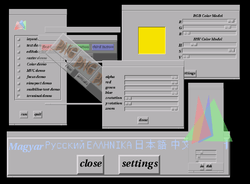Fresco (windowing system)
 | |
| Developer(s) | Various |
|---|---|
| Stable release |
0.2
/ March 4, 2003 |
| Operating system | Unix-like |
| Type | Windowing system |
| License | LGPL2 |
| Website | www.fresco.org |
In computing, Fresco (formerly known as Berlin) was a windowing system intended as a replacement for the X Window System. It was free software, licensed under the terms of the GNU Lesser General Public License (LGPL).
As of October 23, 2008, the last activity in the project's CVS repository was dated June 11, 2004. The project website is no longer registered.
Scope
Fresco tried to use a different approach than most other user interface systems. Its scope was different from for instance the X Window System. In X, Xorg provides graphics and input drivers, drawing primitives (sometimes through extensions), and a network transparent way of using these. Fresco on the other hand aimed to provide the primitives and the network transparency, and in addition to provide the higher level widgets that a GUI toolkit in the X Window System would provide.
Core concepts
A major difference with more traditional systems would have been that higher level widgets existed in a server side scene-graph. This resulted in reduced communication overhead between the application and the display server when manipulating the widgets, because the information needed to re-render the entire scene was there. Keeping the scene on the server also allowed more opportunities to leverage hardware acceleration. OpenGL rendering of everything including the widgets had been implemented, and leveraging more advanced future hardware should have been possible without having to rewrite the client applications.
Everything in the scene-graph was a CORBA Object, and able to be manipulated in a network transparent way. The higher level widgets were built out of lower level primitives in the same way a (remote) client app would. So everything was accessible through a consistent CORBA API.
Fresco tried to be device-independent and resolution-independent. Switching from the OpenGL renderer to the PostScript renderer for printing for instance, should yield identical results.
See also
- General Graphics Interface (GGI)
- InterViews
- Wayland (display server protocol)
- Mir (display server)
- X Window System
External links
- Official website (no longer active: WaybackMachine archive)